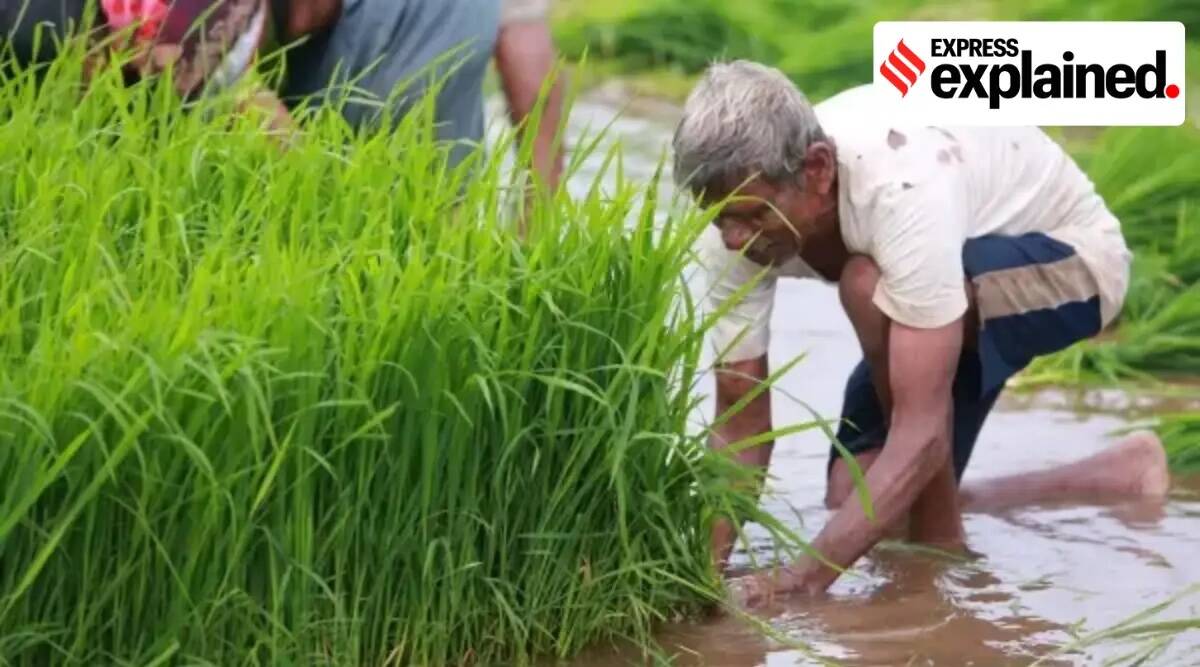The Union Agriculture Ministry announced on Tuesday that Andhra Pradesh has decided to rejoin the crop insurance scheme Pradhan Mantri Fasal Bima Yojana (PMFBY) from the ongoing kharif season. Andhra Pradesh was one of six states that have stopped implementation of the scheme over the last four years. The other five, which remain out, are Bihar, Jharkhand, West Bengal, Jharkhand, and Telangana.
Why did these states opt out?
ANDHRA PRADESH: The state left the PMFBY from rabi season 2019-20. Sources said the state had mentioned several reasons: that the scheme should be voluntary; that states should be given options to choose the risks covered; the scheme should be universal; the cut-off date for enrolment should be flexible; and fourth, the state should be given option to use their own database of E-crop, an application used by the state government to collect information about crops.
“All these issues have been resolved now,” the sources said.
On Tuesday, the Agriculture Ministry announced that Andhra Pradesh has decided to rejoin the PMFBY following talks between Agriculture Minister Narendra Singh Tomar and the Andhra Pradesh Chief Minister Y S Jagan Mohan Reddy.
The move comes days after Union Agriculture Secretary Manoj Ahuja met the CM. On July 7, a team headed by Ahuja gave a presentation to Reddy.
BIHAR: The first state to opt out, from 2018-19, after implementing the scheme in 2016-17 (27.1 lakh farmers insured) and 2017-18 (23 lakh). Sources say there were main three reasons for the state’s decision.
First, the state wanted universal coverage.
Second, the state government wanted zero premium for farmers (meaning the entire premium should be paid by the government.) Under the PMFBY, a farmer is required to pay as premium 2% of the sum insured or actuarial rate, whichever is less, for all kharif foodgrain and oilseed crops; 1.5% of sum insured or actuarial rate, whichever is less, for all rabi foodgrain and oilseed crops; and 5% for horticultural crops. Sources said the Centre can not make farmers’ premium zero. However, states such as Haryana, Goa and Puducherry are paying farmers’ share from their own budget for selected crops.
The third reason was that the rate of premium was very high for Bihar because of the history of claims under earlier schemes.
The Agriculture Ministry is trying to persuade Bihar to rejoin the scheme. On July 1, Ritesh Chauhan, CEO, PMFBY and Joint Secretary in the Ministry, wrote to the Bihar government about addressing its concerns, the sources said.
JHARKHAND: Jharkhand stopped implementing the scheme soon after the Centre revamped it in February 2020, effective from kharif 2020. Under the revised guidelines, “The non-payment of the State Share of premium subsidy within the prescribed timelines as defined in the seasonality discipline will lead to the disqualification of the State Government to implement the scheme in the next season.”
Sources said Jharkhand’s share of premium subsidy was overdue for 2018-19 and 2019-20. This was the main reason that Jharkhand opted out from 2020-21. Besides, there were other “operational challenges” and “political reasons”, the sources said.
Ministry data shows that in Jharkhand 8.8 lakh farmers in 2016-17, 12.0 lakh in 2017-18, 12.9 lakh in 2018-19, and 10.9 lakh in 2019-20 had availed the scheme.
WEST BENGAL: Sources said the reason for West Bengal not implementing the PMFBY is purely “political”. The state wants to implement the scheme without mentioning Pradhan Mantri in the scheme’s name, which is not possible, sources said.
West Bengal implemented the scheme for three years from 2016-17 to 2018-19, covering 41.3 lakh farmers in 2016-17, 40.4 lakh in 2017-18, and 51.3 lakh in 2018-19.
GUJARAT: Gujarat implemented the PMFBY from 2016-17 to 2019-20, covering 19.8 lakh farmers in 2016-17, 17.6 lakh in 2017-18, 21.7 lakh in 2018-19, and 24.8 lakh in 2019-20. Sources say, after the scheme was revamped, Gujarat invited tenders for three years in 2020 but insurance companies quoted a very high premium, and hence the state opted out.
TELANGANA: Telangana too implemented the PMFBY for the initial four years, covering 9.7 lakh, 11 lakh, 8 lakh in 2018-19 and 10.3 lakh farmers in successive yaers before stopping in 2020-21. Sources said Telangana’s share of premium was overdue for 2018-19 and 2019-20, the main reason why it did not notify the scheme for 2020-21.
The Agriculture Ministry is in talks with the state government to bring back on board. A central team made a presentation before of a Group of Ministers of Telangana on June 23, said sources, who expect the state to rejoin from the coming rabi season or next year.
How was the scheme structured, and what has changed since?
The government had launched PMFBY from kharif 2016. Under the scheme, all farmers including sharecroppers and tenant farmers growing “notified crops” in the “notified areas” are eligible for coverage.
Initially, the scheme was compulsory for loanee farmers; in February 2020, the Centre revised it to make it optional for all farmers.
In the initial scheme, the difference between actuarial premium rate and the rate of insurance premium payable by farmers, which is called the rate of normal premium subsidy, was to be shared equally between the Centre and states. However, states and Union Territories are free to extend additional subsidy over and above the normal subsidy from their budgets.
In February 2020, the Centre decided to restrict its premium subsidy to 30% for unirrigated areas and 25% for irrigated areas (from the existing unlimited). Earlier, there was no upper limit for the central subsidy.
Food crops (cereals, millets and pulses); oilseeds; and annual commercial / annual horticultural crops are covered under the scheme. In addition, pilots for coverage can be taken for those perennial horticultural/commercial crops for which standard methodology for yield estimation is available, state the scheme guidelines.
What is the coverage?
As per information shared by the Agriculture Ministry to Lok Sabha in April this year, the number of farmer applications insured increased to 7.65 crore in 2021-22 from 5.83 crore in 2016-17 when the scheme was launched. However, the number of states implementing the scheme had gradually come down from 27 in 2016-17 to 20 in 2021-22.
!function(f,b,e,v,n,t,s)
{if(f.fbq)return;n=f.fbq=function(){n.callMethod?
n.callMethod.apply(n,arguments):n.queue.push(arguments)};
if(!f._fbq)f._fbq=n;n.push=n;n.loaded=!0;n.version=’2.0′;
n.queue=[];t=b.createElement(e);t.async=!0;
t.src=v;s=b.getElementsByTagName(e)[0];
s.parentNode.insertBefore(t,s)}(window, document,’script’,
‘https://connect.facebook.net/en_US/fbevents.js’);
fbq(‘init’, ‘444470064056909’);
fbq(‘track’, ‘PageView’);
.


